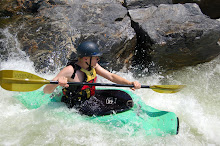Playboating
 This is one example of a whitewater kayak called a playboat. This type of boat is used to do various tricks either while going down a river, or at a certain point in the river called a "playspot," or in the ocean waves. The boat itself is much different than other whitewater kayaks in that they:
This is one example of a whitewater kayak called a playboat. This type of boat is used to do various tricks either while going down a river, or at a certain point in the river called a "playspot," or in the ocean waves. The boat itself is much different than other whitewater kayaks in that they:- have less volume (smaller) to increase manuverability.
- abrupt edges to help the paddler get the edges underwater.
- very flat hull to help the boat spin in tricks and provides a flat surface to surf on.
Playspots are holes or waves mid-river that playboaters find to perform tricks. Some standing waves in rivers are very small and are formed when the water rushes over a rock in the river bed and creates almost a permanent ripple. Other standing waves are wicked huge about 20 feet tall, and look like the river ate a bus. Examples of tricks done are cartwheels - the boat spins 360 degrees vertical, a Blunt - Front flip combined with a 180 etc.
The advantage the internet can give to playboating is by letting people access sites designed around playboaters. Although this seems basic, if the internet wasn't around, it would be extremely hard to figure out exactly what playboat fits you as the paddler. Playboats are specifically designed for different weights and heights, which are not printed or user friendly on the boat. The internet also allows playboaters to gather in an online network and share information about different playspots and hidden rivers, and online instructions and videos.
The advantage the internet can give to playboating is by letting people access sites designed around playboaters. Although this seems basic, if the internet wasn't around, it would be extremely hard to figure out exactly what playboat fits you as the paddler. Playboats are specifically designed for different weights and heights, which are not printed or user friendly on the boat. The internet also allows playboaters to gather in an online network and share information about different playspots and hidden rivers, and online instructions and videos.


0 Comments:
Post a Comment
<< Home